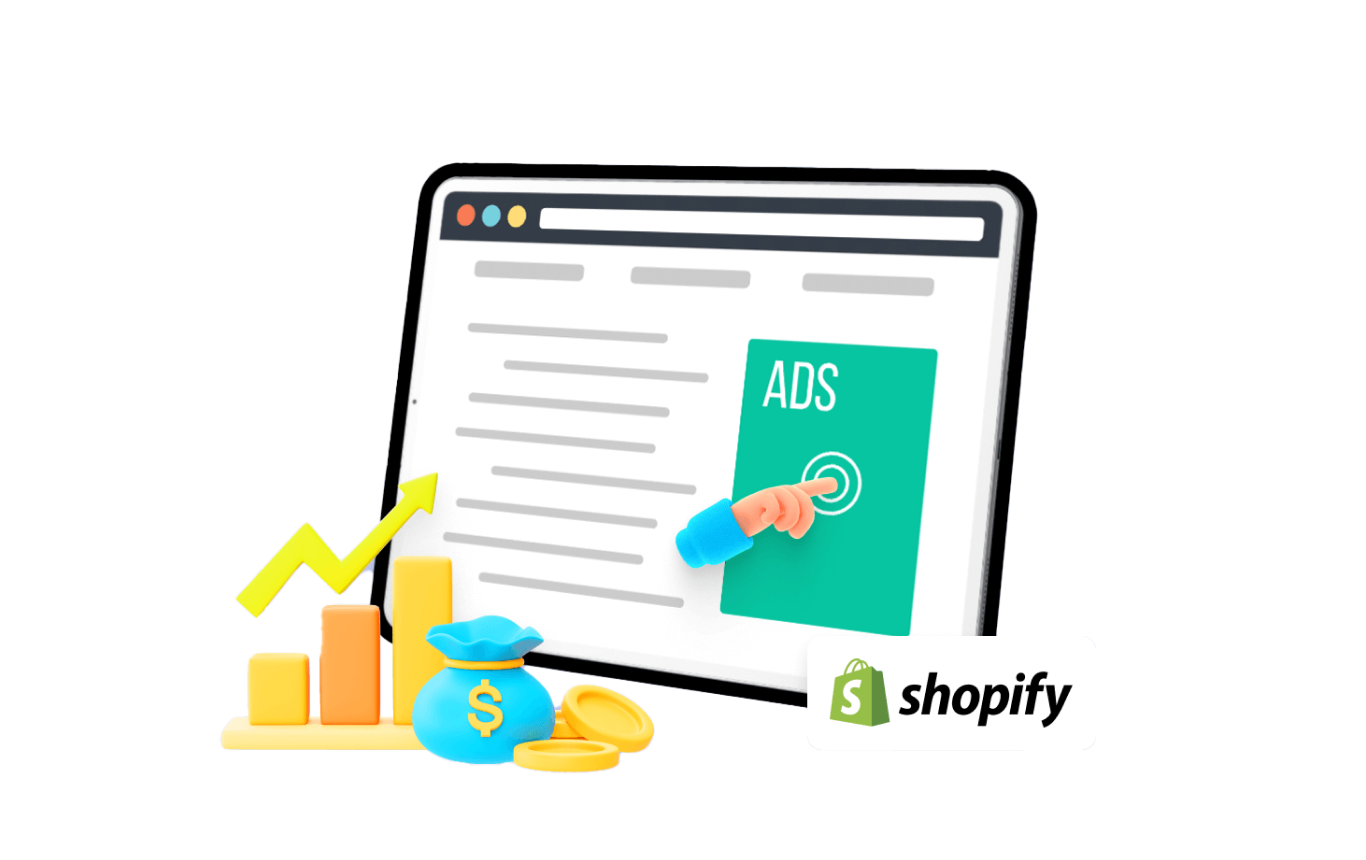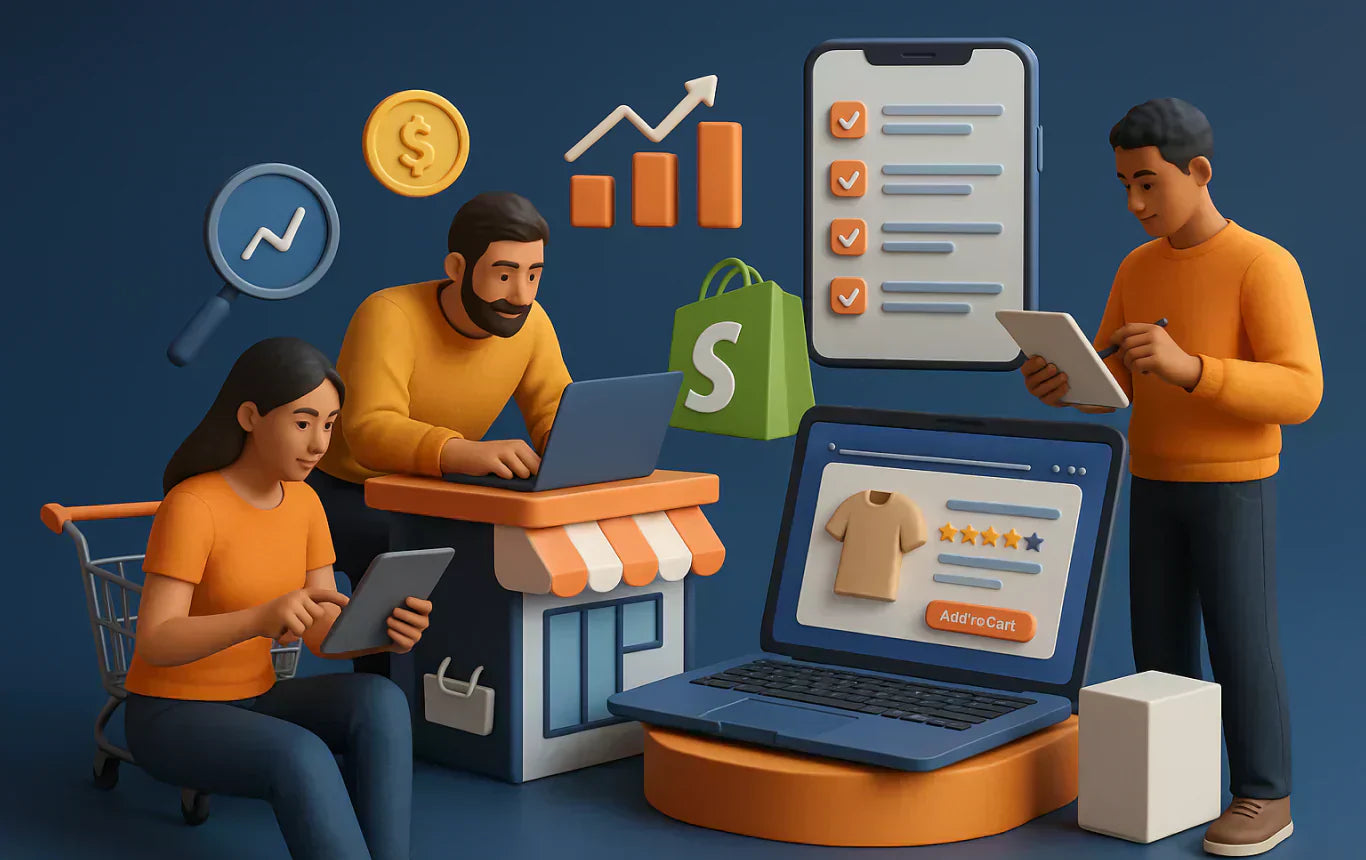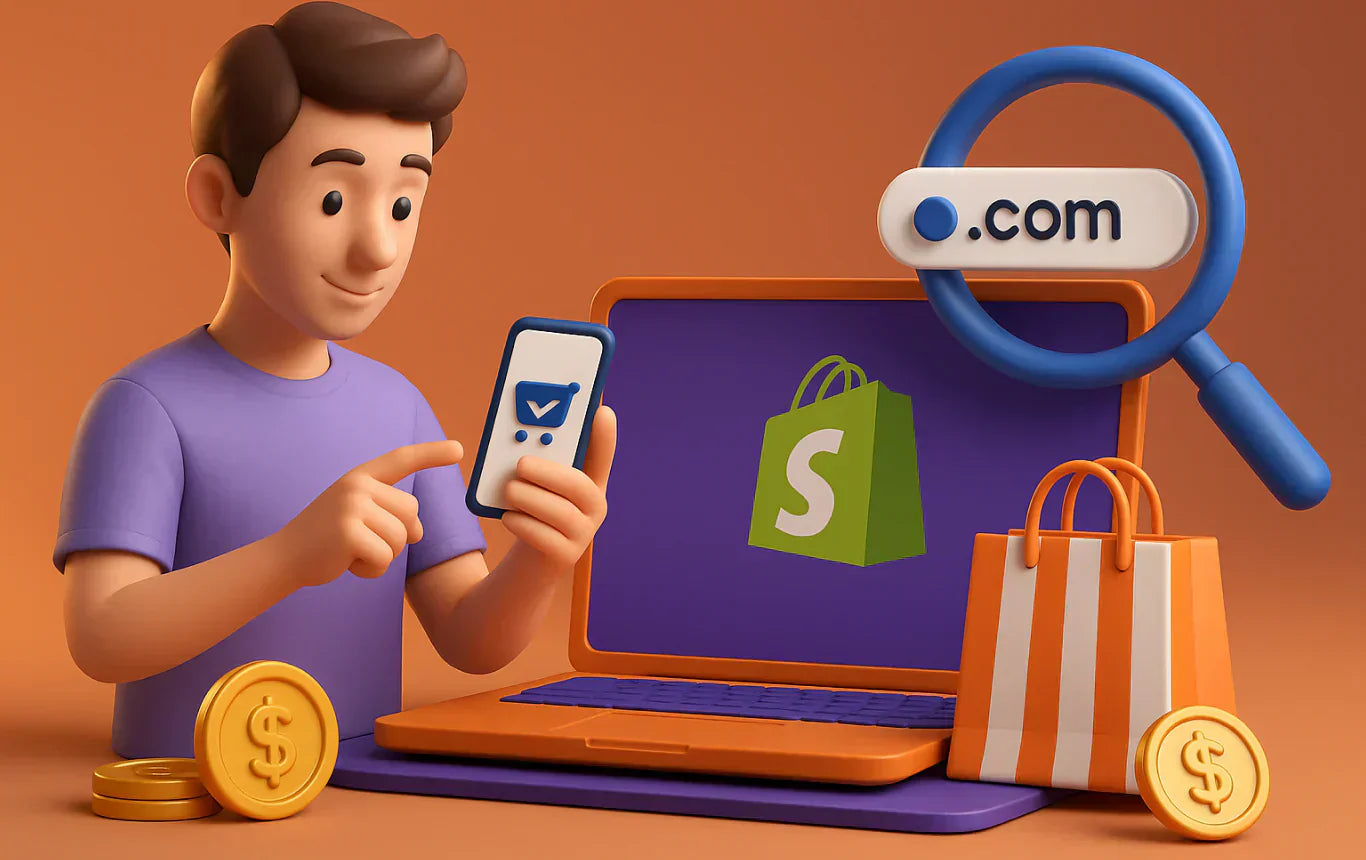Table of Content
The success of any Shopify store depends on a superior marketing strategy. Finding the least expensive ads platforms might make all the difference for Shopify store owners on a tight budget.
This blog will explore several kinds of paid ads, with an emphasis toward Google Ads, social media ads, as well as retargeting ads. By the end of our blog, you will have a thorough knowledge of how to use these ad types to maximize traffic and boost sales at the lowest possible cost.
Diving Into The Advertising Landscape For Shopify Stores
It’s no secret that marketing is an integral part of any business. In the digital age, identifying the best ad platforms can provide several benefits.

The Value Of Marketing
Any online business, including Shopify stores, depends highly on paid advertising. Unlike organic approaches that might take time to show results, paid ads give instant visibility and can efficiently drive traffic to your website. Here's why paid ads are beneficial:
- Immediate Traffic: Paid advertising lets you rapidly direct traffic to your Shopify store at a faster pace than relying on organic means.
- Targeted Marketing: Targeting particular groups, interests, and activities helps you to guarantee that your ads will find possible consumers who will probably convert.
- Measurable Outcomes: Analytics tools included on paid advertising platforms let you monitor performance and base decisions on data.
Types Of Ads Shopify Stores Can Run
When thinking about finding the least expensive ads for Shopify stores, you should analyze all the possibilities. Every kind of ad has benefits and can greatly help to generate traffic and sales. Here is a closer review of the most successful and least expensive ads your Shopify store can run:
Google Ads
Any good marketing plan consists of paid ads, and more often than not, Google is where the magic’s at. Running on a pay-per-click (PPC) model, these ads let your Shopify store show up in search results when potential customers are actively looking for products like yours. Below are the various types of Google ads:
- Search Ads: Targeting particular keywords pertinent to your products, search ads show at the top of Google's search results. For drawing highly relevant and high intent traffic, they are quite successful.
- Shopping Ads: Visually rich ads showcasing your products straight in search results, including images and prices, will appeal to consumers wishing to purchase as they directly show them.
- Display Ads: These ads show up on many Google Display Network websites, raising brand awareness and audience reach.

Social Media Ads
Using social media giants like Facebook and Instagram, social media ads present a strong way of reaching possible customers. These platforms make sure your promotions appeal to the correct audience by using targeted marketing to link with particular groups, demographics, and interests.
- Facebook Ads: These flexible ads let you efficiently present your products by building image, video, and carousel ads, among other forms.
- Instagram Ads: Instagram is perfect for showcasing goods using shoppable posts and interesting video material since it is a visually oriented platform.
- Pinterest Ads: From users actively seeking inspiration and product ideas, promoted pins can drive traffic to your Shopify store.
- TikTok Ads: Through innovative video content, TikTok has become a necessary platform to target younger audiences. Top View ads, branded hashtag challenges, and in-feed ads let you creatively and interactively advertise your products to draw in possible customers.

Retargeting Ads
Retargeting ads are a subset of paid ads meant to reengage consumers who have lately visited your Shopify store. This approach is quite successful since it targets those who already know your brand, increasing conversions. You can retarget customers in two ways:
- Dynamic Retargeting: These ads, which remind consumers of what they liked and inspire them to return, show them the particular products they viewed on your site.
- Abandoned Cart Reminders: Retargeting ads can remind consumers who left goods in their cart to finish their purchase, greatly raising conversion rates.

Carefully combining the ad forms will help you to develop a plan that uses your resources to their full potential and reaches your target market effectively. Knowing these choices will enable your Shopify store to flourish in a competitive market, whether via Google Ads or social media channels.
Now that you know which types of ad options you have, let’s now analyze each type of ad option to find out the least expensive ads for Shopify stores!
Analyzing Google Ads For Shopify Stores
Running paid ads for Shopify stores using Google Ads is among the most efficient ad channels available. Below is a detailed breakdown of the several kinds of Google ads you can try, along with tips on how to make the most of them.
-
Search Ads
When customers search for particular keywords linked to your products, search ads show at the top of Google's search results. Usually text based, they can be rather successful for attracting high intent traffic. Here’s what you get out of them:
Benefits:
- Targeted Reach: Select particular keywords that prospective customers are looking for to make sure your ads show those who would be interested in your goods.
-
High Conversion Rates: Usually more far ahead in the purchasing process, users clicking on search ads often result in better conversion rates.
Budgetary Considerations:
- Cost-Per-Click (CPC): Operating on a CPC model, search ads pay only when someone clicks your ad. This promotes more financial control.
- Long Tail Keywords: While targeting particular audiences, emphasizing long-tail keywords will help you keep costs low.

-
Shopping Ads
Visually rich in nature, shopping ads highlight your products right in Google's search results. These are extremely successful e-commerce ads that show images, prices, and store names.
Benefits:
- Visual Engagement: Shopping ads' strong visual quality often draws more clicks than those of text based ads.
-
Direct Product Links: Users can click directly on the ad to access the product page linked to in your Shopify store.
Budgetary Considerations:
- CPC Model: Shopping ads also run on a CPC basis, thus competition for keywords affects the cost.
- Product Feed Management: Maximizing visibility and efficiency depends on correctly managing your product feed.

-
Display Ads
Display ads show on Google's Display Network's websites. They help raise brand awareness by either text based or image based nature.
Benefits:
- Enhanced Reach: Display ads increase brand awareness by letting you reach customers as they are browsing different websites.
-
Retargeting Opportunities: Retargeting people who have already visited your store will help your advertising reach be more effective.
Budgetary Considerations:
- Low CPC Rates: Since display ads often have lower CPC rates than search ads, they are a less costly option.
- Relevant Targeting: Use targeting options to guarantee your ads find the most relevant groups.
Analyzing Social Media Ads For Shopify Store
With their special targeting powers and formats, social media channels give paid ads for Shopify stores an outstanding avenue. The most successful social media ad kinds are thoroughly analyzed below.
-
Facebook Ads
Among the most flexible and often utilized are Facebook ads for Shopify store owners. They enable several ad formats and exact targeting.
Benefits:
- Targeted Advertising: By means of age, gender, interests, and behavior, you can target particular groups to guarantee that the most relevant possible customers will see your ads.
-
Effective Ad Structures For Engagement: Facebook supports image, video, and carousel ads—which can highlight several products—as well as other ad formats.
Budgetary Considerations:
Adaptable Budgets: Starting with a small daily budget, progressively raise depending on ad performance. Facebook lets one totally control their budget.
Cost-per-click (CPC) and Cost-per-action (CPA): You can help to control costs by optimizing your ads for clicks or particular actions.

-
Instagram Ads
Being a visually oriented platform, Instagram offers special chances for Shopify store owners and nicely complements Facebook ads.
Benefits:
- Visual Engagement: Instagram is a perfect platform for e-commerce since its layout allows products to be showcased effectively.
-
Shopping Features: Using shoppable posts that let customers buy straight through your ads will help to simplify the shopping process.
Budgetary Considerations:
- Similar Bidding Models: Instagram ads run under similar bidding models to Facebook, allowing you to keep budget control.

-
Pinterest Ads
Often neglected, Pinterest is quite a powerful tool for driving traffic to your Shopify store.
Benefits:
- High Intent Users: Higher conversion rates can result since users on Pinterest often come seeking ideas and inspiration.
-
Promoted Pins: Users' feeds and search results may show visually rich promoted pins, raising visibility.
Budgetary Considerations:
- CPC Model: Pinterest ads run on a CPC basis, thus, depending on your target audience, costs can be competitive.

-
TikTok Ads
Younger audiences are abundant on TikTok, which makes it an appealing choice for Shopify store owners looking to target this segment.
Benefits:
- Creative Content: Engaging video ads grab viewers' attention fast and help to increase reach since they are often shared organically.
-
Virality Potential: The algorithm of the platform encourages for organic reach, which can improve the exposure of your ads.
Budgetary Considerations:
- CPC and CPM Options: TikTok lets you pick between paying per click or per thousand impressions, providing flexibility in budget management.

Analyzing Retargeting Ads
Retargeting ads let you reengage people who visited your Shopify store but did not buy anything or those who were about to buy but left items in their cart. This approach can be quite successful, especially for converting potential customers.
Benefits:
- Conversion Potential: Retargeting campaigns concentrate on warm leads already familiar with your products, raising the possibility of conversion.
-
Dynamic Retargeting: You can show particular items that customers have already shown interest in to improve relevance and appeal.
Budgetary Considerations:
- CPC Model: Retargeting runs CPC, like other Google Ads, thus it is a manageable cost when monitored correctly.
- Overspending: Create targeted budgets for retargeting efforts to prevent overspending.
Top Tips To Effectively Use Paid Ads
To make the most of your paid ad strategy, there are certain tips you can follow.
Set Budgets For Paid Ads
Maximizing the return on your advertising initiatives depends on you setting a budget for paid ads directed to your Shopify store:
- Clearly Define Your Objectives: Decide the goals your ads should help to accomplish. Are you trying to increase brand awareness, drive traffic, or create sales? Clearly defined objectives will direct your budgetary distribution.
- Start Small and Scale: Start with a small budget to test several advertising techniques and approaches to targeting. Once you find what works, progressively raise your budget depending on performance criteria.
A/B Testing
Optimizing your advertisement campaigns depends highly on A/B testing.
- Experiment With Several Variables: Test several ad creatives, headlines, images, and calls to action to find what most connects with your target market.
- Examine And Optimize: Analyze the performance data following A/B tests to pinpoint which ads are performing effectively and guide your next campaigns.
Tracking And Analytics
Maximizing ad effectiveness depends on constant monitoring of your ad performance.
- Utilize Tools For Analytics: Track user activity and ad performance by combining tools including Google Analytics, meta business suite and platform specific insights.
- Focus on Key Performance Indicators (KPIs): To evaluate success and guide next campaigns, keep an eye on metrics including click-through rates (CTR), conversion rates, and return on ad spend (ROAS).

Common Shopify Store And Product Page Considerations
Below are some common concerns relating to product pages and general Shopify admin issues that you should be aware of.
How To Change A Picture In Shopify
To change a picture in your Shopify store, simply:
- Log into your admin panel.
- Visit the product page you wish to edit.
- Click on the picture and upload a new one.
- Save your changes.
How To Remove An Example Product Title In Shopify?
To either remove or edit the example product title, simply:
- Click on the "Products" section in your administrative panel.
- Click the item you want changed.
- Either delete the title or change it.
- Save your changes.
Where To Find Store Pin On Shopify?
- Scroll to the "Security" section
- Click on Shopify account settings to view the store pin. Many times, safe access to your account depends on this pin.
How Can I Get A Pre-Built Shopify Store?
Many websites offer pre-built Shopify stores catered to particular niches. Look for the best website for pre-built Shopify stores and analyze each according to your requirements.
Conclusion
Finding the least expensive ads for your Shopify store calls for a calculated strategy combining Google Ads and social media ads. Understanding the several kinds of ads that are out there and their cost structures will help you allocate your money to generate traffic and sales.
Create a complete advertising plan by using search ads, shopping ads, display ads, and retargeting ads run through Google, Facebook, Instagram, Pinterest, or TikTok. Using best practices, including performance monitoring, A/B testing, and budgeting, will improve your outcomes even more.
Your Shopify store can flourish and expand with the correct strategy, helping you to attract fresh customers and manage costs. Start researching these advertising choices right now and watch your Shopify store thrive!
Book Free Consultation










